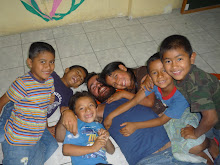(Thursday-Saturday, 23-25 July 2009)
Google map: http://maps.google.co.uk/maps?f=q&source=s_q&hl=pt-PT&geocode=&q=quilotoa+ecuador&sll=53.800651,-4.064941&sspn=12.739664,28.168945&ie=UTF8&ll=-0.830812,-78.767166&spn=0.33642,0.700378&t=h&z=11
This is known as the Quilotoa loop – a several-days hike through the small rural villages around the volcanic lake of Quilotoa.
I spoke to a fellow traveller who had been in Ecuador before, 10 years ago. Back then, he told me, tourism was a all different story, and the Quilotoa lake, for instance, was pretty much unknown and unexploited. Today the lake has a few souvenir stalls around (not enough to ruin the atmosphere, though), and the hike is recommended by pretty much every travel guidebook.
I was afraid of getting into an overdeveloped route, but the truth is that I haven’t. For instance, I didn’t cross any other tourist in the treks during my 3-day hike, and happen to be all alone in one of the hostels I stayed in. I was able to see stunning scenery, get to know a bit of the life in remote rural villages in Ecuador, and engage with some of the locals, either when they crossed my way and I had to ask indications on the path to follow, or playing volleyball in the main plaza of the village, at the end of day.
It felt to me the right level of tourism development – enough so that you can easily find relatively good trail maps and indications on how to get to the different places; enough so that you have 1 or 2 decent hostel options in each village; but not too much so that the hike looses authenticity.
To be honest, it was a 5 stars experience…
Google map: http://maps.google.co.uk/maps?f=q&source=s_q&hl=pt-PT&geocode=&q=quilotoa+ecuador&sll=53.800651,-4.064941&sspn=12.739664,28.168945&ie=UTF8&ll=-0.830812,-78.767166&spn=0.33642,0.700378&t=h&z=11
This is known as the Quilotoa loop – a several-days hike through the small rural villages around the volcanic lake of Quilotoa.
I spoke to a fellow traveller who had been in Ecuador before, 10 years ago. Back then, he told me, tourism was a all different story, and the Quilotoa lake, for instance, was pretty much unknown and unexploited. Today the lake has a few souvenir stalls around (not enough to ruin the atmosphere, though), and the hike is recommended by pretty much every travel guidebook.
I was afraid of getting into an overdeveloped route, but the truth is that I haven’t. For instance, I didn’t cross any other tourist in the treks during my 3-day hike, and happen to be all alone in one of the hostels I stayed in. I was able to see stunning scenery, get to know a bit of the life in remote rural villages in Ecuador, and engage with some of the locals, either when they crossed my way and I had to ask indications on the path to follow, or playing volleyball in the main plaza of the village, at the end of day.
It felt to me the right level of tourism development – enough so that you can easily find relatively good trail maps and indications on how to get to the different places; enough so that you have 1 or 2 decent hostel options in each village; but not too much so that the hike looses authenticity.
To be honest, it was a 5 stars experience…
.
.
=== Day 1 - Zumbahua, Laguna Quilotoa and Chugchilán ===

 Laguna Quilotoa - why go so far, to Ecuador, to see this? I could go to Açores instead, right? ;-)
Laguna Quilotoa - why go so far, to Ecuador, to see this? I could go to Açores instead, right? ;-)

 Frequent crossings with locals, navigating the trails on their daily lives, from one village to the other, from one field to the other. Despite speaking Quichua (and not much Spanish), they're were instrumental in keeping me on the right track these three days...
Frequent crossings with locals, navigating the trails on their daily lives, from one village to the other, from one field to the other. Despite speaking Quichua (and not much Spanish), they're were instrumental in keeping me on the right track these three days...














No comments:
Post a Comment